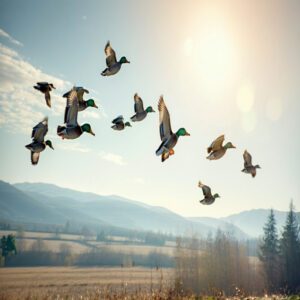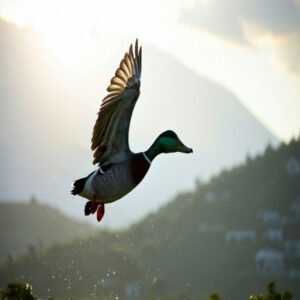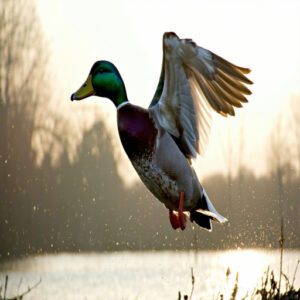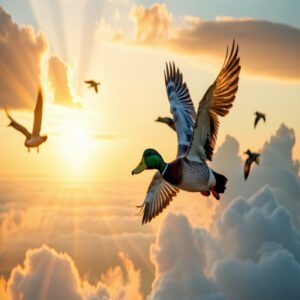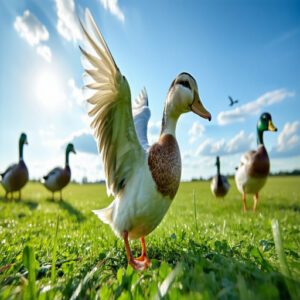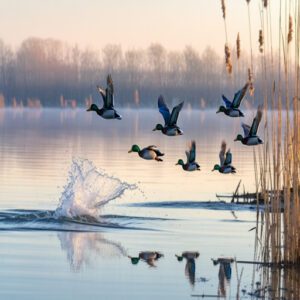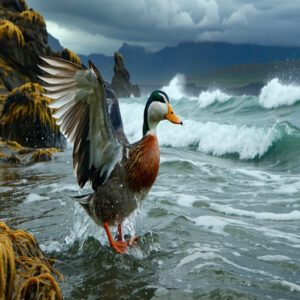This site is supported by our readers. We may earn a commission, at no cost to you, if you purchase through links.
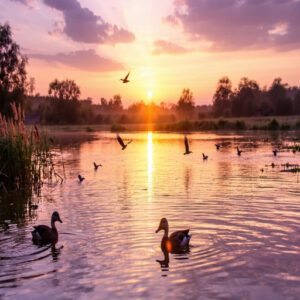
Wild ducks are built for flight, with strong wing muscles and streamlined bodies. They can hit speeds of 40 to 100 mph and cover thousands of miles during migration, using tailwinds to save energy.
Ducks like the northern pintail can even fly non-stop for over 3,000 kilometers!
However, domestic ducks often can’t fly due to selective breeding for size or egg-laying, which limits their wings’ ability to lift them. Whether soaring across flyways or grounded in backyards, a duck’s ability to fly depends on its genetics and environment.
Table Of Contents
Key Takeaways
- Wild ducks are incredible flyers, capable of traveling thousands of miles during migration at speeds of up to 100 mph, thanks to their strong wings and streamlined bodies.
- Domestic ducks generally can’t fly due to selective breeding for traits like size or egg production, which limits their wing strength and lift.
- Ducks’ flight ability is influenced by factors like genetics, environment, health, and adequate nutrition, which support wing muscle development and endurance.
- Some wild ducks, like flightless species in isolated habitats, can’t fly because they’ve evolved heavier bodies and smaller wings in predator-free environments.
Can Ducks Fly?
Sure, ducks can fly—but it’s not the same across the board.
Wild ducks are built for it, with Duck Wing Structure and Aerodynamic Feathers that let them travel jaw-dropping distances. Ever heard of Bird Migration? Blue-winged teals trek 6,000 km, and king eiders go up to 10,000 km.
They’re swift, too, zipping through skies at 40-100 mph. Understanding duck characteristics is essential to grasping their flight capabilities.
Now, domestic ducks are another story. Selective breeding for size or egg-laying often grounds them. Breeds like Pekins and Indian Runners just can’t keep up.
So, if you’re asking, “Can ducks fly?” The answer depends—wild ducks soar, domestic ducks stay grounded.
Flight Capabilities of Ducks
Ducks are strong fliers with impressive abilities like long-distance migration and speeds up to 50 miles per hour.
Their flight is powered by streamlined bodies, powerful wing muscles, and efficient formations that help conserve energy.
Migration Distance
Ducks are incredible long-distance migrants, flying thousands of miles during seasonal journeys. Northern pintails can travel 3,000 kilometers non-stop, while king eiders log up to 10,000 kilometers annually.
Understanding duck migration patterns is essential for conservation efforts.
- Fly patterns depend on weather, food, and genetics.
- Migration routes lead through major flyways like the Mississippi.
- Some ducks use tailwinds to extend their range and conserve energy.
Flight Speed
Cruising through the skies, ducks typically reach speeds of 40–60 mph.
During migration, mallards maintain an average duck speed of 50 mph, while Canvasbacks push up to 70 mph.
The Red-breasted Merganser, a true speedster, holds the record at 100 mph.
Ducks’ pointed wings, as explained in this duck flight guide, are essential for sustained high-speed flight.
Thanks to their aerodynamic lift, efficient wing beats, and well-tuned flight patterns, ducks masterfully handle air resistance and speed limits.
Flight Mechanics
Ever wondered how ducks fly so swiftly?
It’s all in their flight mechanics. Strong flight muscles, aerodynamic feathers, and rapid wing movement work together to beat air resistance.
Ducks’ wings create lift by manipulating airflow, while their asymmetrical feathers improve flight patterns.
Short distances or long migrations? They’re built for both, thanks to precision duck aerodynamics and a wingspan designed for efficiency.
Flight Endurance
Ducks are marathoners of the sky! Their flight endurance allows non-stop journeys over 6,000 kilometers.
How? They’ve got impressive wing design for efficient flying, strong muscles, and clever energy-saving tricks.
- Flight Patterns like V-formations reduce drag.
- Stored fat reserves fuel long-distance missions.
- Aerodynamic Boost from pointed wings minimizes wing fatigue.
That’s how they outlast tough conditions.
Factors Affecting Duck Flight
A duck’s ability to fly depends on several factors, like its genetics, environment, and overall health.
Things like nutrition and wing strength also play a big part in whether it’s soaring across the skies or staying closer to the ground.
Genetics
Flying abilities in ducks boil down to genetics.
Hereditary factors like wing muscle strength, feather structure, and molting cycles define how well a duck can fly.
Some breeds, such as Khaki Campbell and Buff Orpington, can barely get airborne.
Gene expression from selective breeding also plays a role in shaping duck flight characteristics, influencing whether they’re natural flyers or grounded, which is influenced by hereditary factors.
Environment
Healthy habitats make all the difference for duck flight.
Clean water supports swimming and feeding, while reliable food sources fuel long migrations.
Safe nesting sites shield against predators, helping ducks build strong feathers and muscles.
Climate change can disrupt migration patterns and habitat conservation, impacting waterfowl flight.
Protecting wetlands guarantees flying ducks thrive, answering “can ducks fly” with a resounding yes, highlighting the importance of wetlands.
Nutrition
A well-balanced duck diet is the secret to strong flight.
Meeting your duck’s nutrient needs with high-quality Duck Feed and dietary supplements guarantees proper muscle development.
Ducks need steady energy, especially during migration.
Prioritize reliable food sources and clean water quality to maximize duck health and maintain stamina.
Proper duck care and duck maintenance boost behavior and flight performance naturally.
Health
Good health keeps ducks in the air. Focused duck nutrition, regular exercise, and proper care strengthen their flight capabilities.
Understanding that are ducks birds informs us about their physical characteristics and adaptations.
Watch for wing injuries and maintain duck feathers for aerodynamics.
To help:
- Offer a well-balanced diet.
- Check for beak health regularly.
- Prevent overcrowding in coops.
- Monitor molting processes to avoid weakness.
- Protect ducks from injuries and predators.
Domestic Ducks and Flight
You might think domestic ducks can soar like their wild cousins, but most can’t get far off the ground.
Selective breeding has made many heavier or given them smaller wings, leaving them better suited for waddling than flying.
Reasons for Flightlessness
Flightlessness in ducks isn’t random—it’s shaped by their body structure, habitat factors, and adaptations.
On islands without predators, flightless duck species evolved smaller wings and heavier bodies, trading flight for easier survival.
Feather loss during the molting process can also leave ducks temporarily flightless.
These traits, while beneficial in predator-free environments, make flightless duck breeds vulnerable when new threats appear.
- Key reasons for flightlessness:
-Small wing size limits lift and propulsion.
-Stable habitats reduce flight necessity.
-Evolution favors aquatic mobility over air.
Breeding Influence
So, can ducks fly?
Well, wild ones sure can, but domestic duck breeds often struggle, thanks to selective breeding methods.
These genetic factors lead to shorter wings and weaker muscles, making most domestic ducks grounded, focusing on hereditary traits that prioritize convenience over survival.
Unlike their wild cousins—such as the mallard duck flying effortlessly—domestic breeds like the Pekin or Indian Runner simply aren’t built for it, due to selective breeding.
Do ducks fly? Wild ones do. Domestic ones? Not so much.
Flight Behavior of Wild Ducks
Wild ducks are impressive fliers, using strong wings and streamlined bodies to take off from water with ease.
During migration, they often stay low to the ground, conserving energy while traveling long distances.
Takeoff From Water
Can ducks fly straight off water? Absolutely, but it depends on their style. Dabbling ducks like Mallards use rapid wing thrusts and leap almost vertically, while diving ducks need a running start on the water’s surface for lift.
Ducklings learn these aquatic departure tricks early, mimicking adults’ every move.
Here’s how ducks master water takeoff:
- Quick bursts of wing flapping for Feather Lift
- Strong Duck Paddling for momentum
- Sharp focus to avoid obstacles
- Spaced-out flocks for smoother Aquatic Departure
- Practiced coordination for vertical takeoff
Duck wingspan and strength make these techniques efficient.
Low Flight During Migration
Ducks have mastered the art of flying low during migration, sticking close to water bodies and trees for smart altitude control. This strategic choice keeps them safer, faster, and more efficient along migration routes.
Internal biological clocks and environmental cues, like changing daylight hours, heavily influence these seasonal bird behavior changes. Low altitudes help ducks avoid wind resistance, conserve energy, and use natural landmarks for better navigation.
Plus, flying low allows for quick dives into water if predators are near. The benefits of this approach include:
- Altitude control: Hugging closer to the ground saves energy.
- Safety: Reduces exposure to aerial predators.
- Wind resistance: Low altitudes mean smoother sailing.
- Swift landings: Water’s always within reach.
- Migration routes: Easier to follow natural landmarks.
Flightless Duck Species
Some ducks, like the Steamer Ducks of southern Argentina and Chile, can’t fly due to their heavy bodies and strong legs built for swimming.
Others, like New Zealand’s endangered flightless teal, have adapted to flightlessness because of their isolated and predator-free habitats.
Southern Argentina and Chile Steamer Ducks
Not all ducks flying across coasts boast the same flight capabilities.
Steamer Ducks, found along Southern Argentina and Chile’s rugged shores, paddle through waters instead of flying.
Their habitat includes shallow coastal areas, where they feast on mollusks and crustaceans.
Known for their aggressive nature, these waterfowl use their wings like oars, resembling tiny steamboats.
The study of duck characteristics reveals intriguing insights into their physical features and behaviors.
Avian research highlights their evolving flightlessness, making them a fascinating example of adaptation.
Waterfowl conservation efforts help protect this unique species, which is an important aspect of preserving biodiversity.
Endangered Flightless Teal in New Zealand
If you’ve ever wondered, “Can ducks fly?”—well, some can’t, like New Zealand’s endangered flightless teal.
These unique ducks, including the Auckland teal and Campbell Island teal, have adapted to a predator-free lifestyle, losing the ability to fly.
Sadly, introduced predators and habitat loss have made survival tough.
Conservation efforts focus on protecting teal habitats and launching breeding programs to boost their numbers.
By reintroducing these flightless ducks into predator-free areas, wildlife experts hope to secure their future.
It’s a race to save one of New Zealand’s rarest species!
Backyard Ducks and Flight
If you’ve ever wondered whether your backyard ducks can take to the skies, the answer depends on their breed and weight.
Most domestic ducks can only manage short, low flights, but they’re often too heavy or lack the right wing strength to fly far.
Flight Ability of Backyard Ducks
Backyard ducks, especially domestic breeds like Pekin and Indian Runner, usually can’t fly due to their duck wing structure, breeding, and limited space.
While their flight patterns are nearly non-existent, giving them larger enclosures can help maintain health.
Without proper space, they may face obesity or wing deformities.
Though duck flying is rare in backyard settings, gradual exposure to open areas boosts small flights and muscle strength.
A well-planned backyard habitat encourages activity, mimicking natural feather maintenance and keeping them happy.
Considerations for Domestic Settings
Thinking about raising pet ducks?
Start with a secure duck enclosure.
Most domestic duck breeds, like the Pekin, are bred for non-flight, so they’ll stay grounded.
But some, like Call Ducks, can surprise you with their flying skills.
Use proper fencing options as flight barriers to guarantee they don’t wander off.
For effective Duck Enclosure designs, consider the space and safety needs of your ducks.
Beyond safety, focus on proper nutrition and keeping predators at bay.
Wondering, “Can ducks fly or migrate?”
For domestic breeds, the answer is almost always no.
With care, your backyard ducks will thrive and keep you entertained.
Development of Duck Flight
You might be surprised to learn how much a duck’s ability to fly depends on its stages of growth.
From hatching to adulthood, their wings, muscles, and feathers gradually develop, giving them the strength and structure needed for flight.
Incubation and Fledging
During incubation, female ducks rely on brooding techniques, keeping 8-12 eggs warm for about 28 days.
Once hatched, ducklings swiftly adapt, swimming immediately while relying on their mother’s guidance.
As fledglings, their nesting habits are essential for safety. Over the next 50-60 days, their feathers grow, setting the stage for flight. So, do ducks fly? Soon enough, they will, and it is interesting to consider their ability to swim immediately after hatching.
Juvenile Development
By 4 months, ducklings are ready to test their wings.
Their fledgling stage depends on feather development, proper wing formation, and overall health.
Keep them safe with good food and space to grow.
Challenges like juvenile molting, competition, or illness could slow progress, but strong care builds strength and stamina.
That’s how baby ducks learn the basics of flight with ease!
Adult Size
Once they’re fully grown, ducks hit near-adult size fast.
Mallards, for example, usually weigh 2-3 pounds with a wing span of 32-38 inches.
Factors like body weight, balanced diets, and strong leg strength guarantee proper development.
Plus, feather growth and solid beak size play supporting roles.
Curious if ducks can fly well? It all starts here—healthy growth builds the foundation.
Frequently Asked Questions (FAQs)
Are ducks able to fly?
Most ducks can fly, but it depends on the species.
Wild ducks are strong flyers, often migrating thousands of miles, while domestic ducks are usually bred to be flightless, making short hops instead of soaring.
Do ducks fly long distances?
While some ducks barely budge from ponds,
many wild species are marathon fliers.
They can travel thousands of miles during migration,
flying up to 8 hours nonstop,
reaching altitudes as high as 20,000 feet.
How do ducks fly?
Ducks fly by flapping their long, pointed wings quickly, up to ten beats per second, creating lift.
They take off with a leap, glide gracefully, and land smoothly.
Strong chest muscles power their flight.
Do migratory ducks fly?
Imagine tracing invisible highways across the sky – that’s how migratory ducks travel.
They fly hundreds or even thousands of miles, using V-formations for energy and safety, traversing seasonal shifts with astonishing endurance and precision.
Do domesticated ducks fly?
Most domesticated ducks can’t fly due to their heavier bodies and smaller wings, thanks to selective breeding.
While some might flutter short distances, they’re grounded compared to their wild cousins.
Feather clipping keeps them earthbound too, highlighting the effect of selective breeding.
Are there wild ducks that can’t fly?
Yep, some wild ducks can’t fly, like during molting when they lose feathers for a few weeks.
Others, like certain island species, never adapted to flying since they’ve got food and safety right there.
Can ducks fly in the sky?
Ducks can absolutely take to the sky, soaring with ease thanks to their strong wings and streamlined bodies.
Wild ducks, especially, are skilled fliers, zipping through the air at speeds up to 60 mph!
Why can’t domesticated ducks fly?
Domesticated ducks can’t fly because people bred them for traits like size and egg production, not flight.
Their heavier bodies, smaller wings, and weaker muscles make getting airborne nearly impossible, even for short distances, due to their breeding for traits like size.
What type of ducks can’t fly?
Some duck breeds, like Pekins, Indian Runners, and Cayugas, can’t fly because they’re bred for specific traits like size or egg production.
Their wings are too small, and they lack the muscle power to lift off.
Can ducks fly from land?
Ducks can take off from land, but it’s like watching an awkward runway show.
They need a running start to get enough lift.
Their strong wings and powerful muscles make it possible despite the clumsy takeoff.
Conclusion
Ducks are fascinating regarding flight.
Picture them soaring through the sky at speeds of up to 100 mph or traveling thousands of miles during migration—it’s impressive!
Most wild ducks can fly thanks to their strong bodies and wings, while domestic ducks often stay grounded due to selective breeding.
Whether it’s wild or backyard ducks, their ability to take flight depends on genetics, environment, and health.
So, can ducks fly?
Most definitely, but not all are built for it!
- https://www.treehugger.com/fun-facts-about-ducks-4043231
- https://www.reddit.com/r/NoStupidQuestions/comments/60qfev/can_ducks_fly/
- https://www.birdzilla.com/learn/can-ducks-fly/
- https://www.ducks.ca/stories/conservator/how-duck-flight-works/
- https://www.ducks.org/conservation/waterfowl-research-science/the-big-four-diving-ducks

